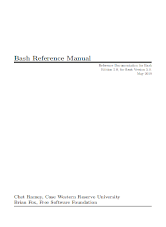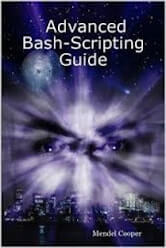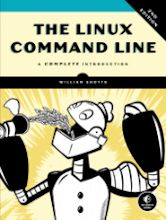Last Updated on May 22, 2022
Bash (acronym for the ‘Bourne-Again-SHell’) is the GNU Project’s shell and programming language. It’s an sh-compatible shell that incorporates useful features from the Korn shell (ksh) and C shell (csh). Bash has become a de facto standard for shell scripting. It runs on almost all versions of Unix and a few other operating systems including Windows platforms.
A Unix shell is both a command interpreter and a programming language. As a command interpreter, the shell provides the user interface to various utilities. The programming language features of Bash allow these utilities to be combined. Files containing commands can be developed, and become commands themselves. A shell script is therefore a quick way of prototyping a complex application. Shell scripting follows the classic Unix philosophy of breaking complex projects into simpler subtasks, of chaining together components and utilities.
Like all Unix shells, Bash supports filename globbing (wildcard matching), piping, here documents, command substitution, variables and control structures for condition-testing and iteration. The keywords, syntax and other basic features of the language were all copied from sh.
1. GNU Bash Reference Manual by Chet Ramey, Brian Fox
 GNU Bash Reference Manual is the definitive reference for GNU Bash, the standard GNU command-line interpreter.
GNU Bash Reference Manual is the definitive reference for GNU Bash, the standard GNU command-line interpreter.
GNU Bash is a complete implementation of the POSIX2 shell specification (/bin/sh), with additional features from the C-shell (csh) and Korn shell (ksh). The name is an acronym for the ‘Bourne-Again SHell’, a pun on Stephen Bourne, the author of the direct ancestor of the current Unix shell sh, which appeared in the Seventh Edition Bell Labs Research version of Unix.
The book explores:
- Basic Shell Features – briefly summarizes the shell’s ‘building blocks’: commands, control structures, shell functions, shell parameters, shell expansions, redirections, which are a way to direct input and output from and to named files, and how the shell executes commands.
- Shell Builtin Commands – briefly describes the builtins which Bash inherits from the Bourne Shell, as well as the builtin commands which are unique to or have been extended in Bash.
- Shell Variables – describes the shell variables that Bash uses. Bash automatically assigns default values to a number of variables.
- Bash Features – describes features unique to Bash:
- Invoking Bash – Command line options that you can give to Bash.
- Bash Startup Files – When and how Bash executes scripts.
- Interactive Shells – What an interactive shell is.
- Bash Conditional Expressions – Primitives used in composing expressions for the test builtin.
- Shell Arithmetic – Arithmetic on shell variables.
- Aliases – Substituting one command for another.
- Arrays – Array Variables.
- The Directory Stack – History of visited directories.
- Printing a Prompt – Controlling the PS1 string.
- The Restricted Shell – A more controlled mode of shell execution.
- Bash POSIX Mode – Making Bash behave more closely to what the POSIX standard specifies.
- Job Control – discusses what job control is, how it works, and how Bash allows you to access its facilities.
- Command Line Editing – describes the basic features of the GNU command line editing interface including readline interaction, bindable readline commands, and programmable completion.
- Using History Interactively – describes how to use the GNU History Library interactively, from a user’s standpoint.
- Installing Bash – provides basic instructions for installing Bash on the various supported platforms.
2. Advanced Bash Scripting Guide by Mendel Cooper
 Advanced Bash-Scripting Guide is an in-depth exploration of the art of scripting. Almost the complete set of commands, utilities, and tools is available for invocation by a shell script.
Advanced Bash-Scripting Guide is an in-depth exploration of the art of scripting. Almost the complete set of commands, utilities, and tools is available for invocation by a shell script.
The book explains:
- Basics such as special characters, quoting, exit and exit status.
- Beyond the Basics including loops and branches, command substitution, arithmetic expansion, recess time.
- Commands – Internal commands and builtins; External filters, programs and commands; System and Administrative Commands.
- Advanced topics: Regular Expressions, Here Documents, I/O Redirection, Subshells, Restricted Shells, Process Substitution, Functions, Aliases, List Constructs, Arrays, Indirect References, /dev and /proc, Of Zeros and Nulls, Debugging, Options, Gotchas, Scripting with Style.
This book is in the public domain.
3. The Linux Command Line by William Shotts
 The Linux Command Line includes an excellent primer on Bash scripting. It also offers a broad overview of ‘living’ on the Linux command line.
The Linux Command Line includes an excellent primer on Bash scripting. It also offers a broad overview of ‘living’ on the Linux command line.
Unlike some books that concentrate on just a single program, such as the shell, bash, this book will try to convey how to get along with the command line interface in a larger sense. How does it all work? What can it do? What’s the best way to use it?
The book is divided into the following parts:
- Learning The Shell starts the exploration of the basic language of the command line including such things as the structure of commands, file system navigation, command line editing, and finding help and documentation for commands.
- Configuration And The Environment covers editing configuration files that control the computer’s operation from the command line.
- Common Tasks And Essential Tools explores many of the ordinary tasks that are commonly performed from the command line. Unix-like operating systems, such as Linux, contain many ‘classic’ command line programs that are used to perform powerful operations on data.
- Writing Shell Scripts introduces shell programming, an admittedly rudimentary, but easy to learn, technique for automating many common computing tasks. By learning shell programming, you will become familiar with concepts that can be applied to many other programming languages.
The book is released under a Creative Commons Attribution-NonCommercial-NoDerivs 3.0 Unported (CC BY-NC-ND 3.0) license.
Next page: Page 2 – Bash Guide for Beginners and more books
Pages in this article:
Page 1 – GNU Bash Reference Manual and more books
Page 2 – Bash Guide for Beginners and more books
All books in this series:
| Free Programming Books | |
|---|---|
| Ada | ALGOL-like programming language, extended from Pascal and other languages |
| Agda | Dependently typed functional language based on intuitionistic Type Theory |
| Arduino | Inexpensive, flexible, open source microcontroller platform |
| Assembly | As close to writing machine code without writing in pure hexadecimal |
| Awk | Versatile language designed for pattern scanning and processing language |
| Bash | Shell and command language; popular both as a shell and a scripting language |
| BASIC | Beginner’s All-purpose Symbolic Instruction Code |
| C | General-purpose, procedural, portable, high-level language |
| C++ | General-purpose, portable, free-form, multi-paradigm language |
| C# | Combines the power and flexibility of C++ with the simplicity of Visual Basic |
| Clojure | Dialect of the Lisp programming language |
| ClojureScript | Compiler for Clojure that targets JavaScript |
| COBOL | Common Business-Oriented Language |
| CoffeeScript | Transcompiles into JavaScript inspired by Ruby, Python and Haskell |
| Coq | Dependently typed language similar to Agda, Idris, F* and others |
| Crystal | General-purpose, concurrent, multi-paradigm, object-oriented language |
| CSS | CSS (Cascading Style Sheets) specifies a web page’s appearance |
| D | General-purpose systems programming language with a C-like syntax |
| Dart | Client-optimized language for fast apps on multiple platforms |
| Dylan | Multi-paradigm language supporting functional and object-oriented coding |
| ECMAScript | Best known as the language embedded in web browsers |
| Eiffel | Object-oriented language designed by Bertrand Meyer |
| Elixir | Relatively new functional language running on the Erlang virtual machine |
| Erlang | General-purpose, concurrent, declarative, functional language |
| F# | Uses functional, imperative, and object-oriented programming methods |
| Factor | Dynamic stack-based programming language |
| Forth | Imperative stack-based programming language |
| Fortran | The first high-level language, using the first compiler |
| Go | Compiled, statically typed programming language |
| Groovy | Powerful, optionally typed and dynamic language |
| Haskell | Standardized, general-purpose, polymorphically, statically typed language |
| HTML | HyperText Markup Language |
| Icon | Wide variety of features for processing and presenting symbolic data |
| J | Array programming language based primarily on APL |
| Java | General-purpose, concurrent, class-based, object-oriented, high-level language |
| JavaScript | Interpreted, prototype-based, scripting language |
| Julia | High-level, high-performance language for technical computing |
| Kotlin | More modern version of Java |
| LabVIEW | Designed to enable domain experts to build power systems quickly |
| LaTeX | Professional document preparation system and document markup language |
| Lisp | Unique features - excellent to study programming constructs |
| Logo | Dialect of Lisp that features interactivity, modularity, extensibility |
| Lua | Designed as an embeddable scripting language |
| Markdown | Plain text formatting syntax designed to be easy-to-read and easy-to-write |
| Objective-C | Object-oriented language that adds Smalltalk-style messaging to C |
| OCaml | The main implementation of the Caml language |
| Pascal | Imperative and procedural language designed in the late 1960s |
| Perl | High-level, general-purpose, interpreted, scripting, dynamic language |
| PHP | PHP has been at the helm of the web for many years |
| PostScript | Interpreted, stack-based and Turing complete language |
| Prolog | A general purpose, declarative, logic programming language |
| PureScript | Small strongly, statically typed language compiling to JavaScript |
| Python | General-purpose, structured, powerful language |
| QML | Hierarchical declarative language for user interface layout - JSON-like syntax |
| R | De facto standard among statisticians and data analysts |
| Racket | General-purpose, object-oriented, multi-paradigm, functional language |
| Raku | Member of the Perl family of programming languages |
| Ruby | General purpose, scripting, structured, flexible, fully object-oriented language |
| Rust | Ideal for systems, embedded, and other performance critical code |
| Scala | Modern, object-functional, multi-paradigm, Java-based language |
| Scheme | A general-purpose, functional language descended from Lisp and Algol |
| Scratch | Visual programming language designed for 8-16 year-old children |
| SQL | Access and manipulate data held in a relational database management system |
| Standard ML | General-purpose functional language characterized as "Lisp with types" |
| Swift | Powerful and intuitive general-purpose programming language |
| Tcl | Dynamic language based on concepts of Lisp, C, and Unix shells |
| TeX | Markup and programming language - create professional quality typeset text |
| TypeScript | Strict syntactical superset of JavaScript adding optional static typing |
| Vala | Object-oriented language, syntactically similar to C# |
| VHDL | Hardware description language used in electronic design automation |
| VimL | Powerful scripting language of the Vim editor |
| XML | Rules for defining semantic tags describing structure ad meaning |
